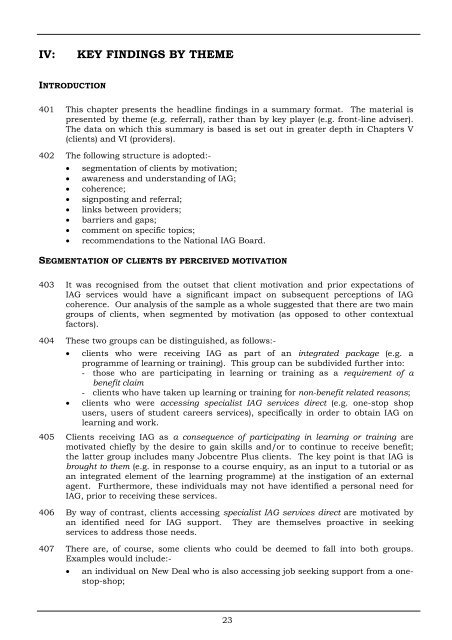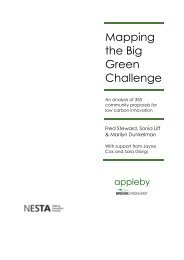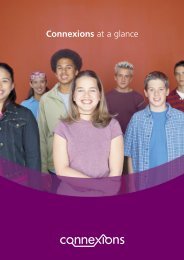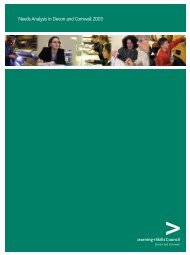Client needs for coherent information, advice and guidance services ...
Client needs for coherent information, advice and guidance services ...
Client needs for coherent information, advice and guidance services ...
Create successful ePaper yourself
Turn your PDF publications into a flip-book with our unique Google optimized e-Paper software.
IV:<br />
KEY FINDINGS BY THEME<br />
INTRODUCTION<br />
401 This chapter presents the headline findings in a summary <strong>for</strong>mat. The material is<br />
presented by theme (e.g. referral), rather than by key player (e.g. front-line adviser).<br />
The data on which this summary is based is set out in greater depth in Chapters V<br />
(clients) <strong>and</strong> VI (providers).<br />
402 The following structure is adopted:-<br />
• segmentation of clients by motivation;<br />
• awareness <strong>and</strong> underst<strong>and</strong>ing of IAG;<br />
• coherence;<br />
• signposting <strong>and</strong> referral;<br />
• links between providers;<br />
• barriers <strong>and</strong> gaps;<br />
• comment on specific topics;<br />
• recommendations to the National IAG Board.<br />
SEGMENTATION OF CLIENTS BY PERCEIVED MOTIVATION<br />
403 It was recognised from the outset that client motivation <strong>and</strong> prior expectations of<br />
IAG <strong>services</strong> would have a significant impact on subsequent perceptions of IAG<br />
coherence. Our analysis of the sample as a whole suggested that there are two main<br />
groups of clients, when segmented by motivation (as opposed to other contextual<br />
factors).<br />
404 These two groups can be distinguished, as follows:-<br />
• clients who were receiving IAG as part of an integrated package (e.g. a<br />
programme of learning or training). This group can be subdivided further into:<br />
- those who are participating in learning or training as a requirement of a<br />
benefit claim<br />
- clients who have taken up learning or training <strong>for</strong> non-benefit related reasons;<br />
• clients who were accessing specialist IAG <strong>services</strong> direct (e.g. one-stop shop<br />
users, users of student careers <strong>services</strong>), specifically in order to obtain IAG on<br />
learning <strong>and</strong> work.<br />
405 <strong>Client</strong>s receiving IAG as a consequence of participating in learning or training are<br />
motivated chiefly by the desire to gain skills <strong>and</strong>/or to continue to receive benefit;<br />
the latter group includes many Jobcentre Plus clients. The key point is that IAG is<br />
brought to them (e.g. in response to a course enquiry, as an input to a tutorial or as<br />
an integrated element of the learning programme) at the instigation of an external<br />
agent. Furthermore, these individuals may not have identified a personal need <strong>for</strong><br />
IAG, prior to receiving these <strong>services</strong>.<br />
406 By way of contrast, clients accessing specialist IAG <strong>services</strong> direct are motivated by<br />
an identified need <strong>for</strong> IAG support. They are themselves proactive in seeking<br />
<strong>services</strong> to address those <strong>needs</strong>.<br />
407 There are, of course, some clients who could be deemed to fall into both groups.<br />
Examples would include:-<br />
• an individual on New Deal who is also accessing job seeking support from a onestop-shop;<br />
23











